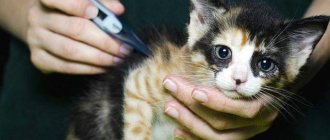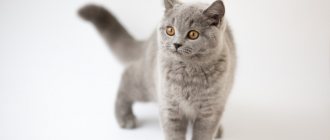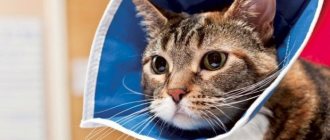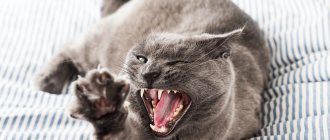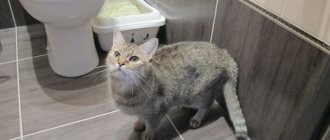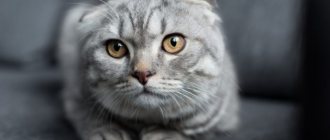Almost every cat owner once faces the question of castration of their pet. It is believed that castration has both positive and negative sides. The cat castration operation itself is not complicated. This is the removal of an animal's gonads through surgery.
Positive aspects of castration of cats:
- The animal's character improves. The cat will become more affectionate, calm and obedient.
- The animal will no longer mark its territory with secretions, leaving an unpleasant odor.
- Aggressive behavior and loud screams at night during “partying” will stop.
- Suppressed sexual instincts will not force the cat to look for a partner and rush outside. He will become a quiet pet.
- The risk of contracting a sexually transmitted infection is practically eliminated, and interest in cats disappears.
- Neutered cats live longer, about 3-4 years, as they lead a calmer home life.
All this has a positive effect on both the animal itself and the owner.
Possible negative points:
- After surgery, the cat begins to eat with a vengeance due to hormonal changes. Becomes less mobile and lazy. All this leads to pet obesity. These troubles can be solved by proper feeding and increasing the activity of the animal.
- After surgery, adult cats may still have problems walking and singing. Since in adult (mature) cats, not only the testes, but also the pituitary gland are responsible for the production of hormones. The castration operation may become useless. But it will help solve the problem of tag smell.
- There may be problems in the functioning of the cardiovascular system immediately after the operation. This is due to the use of anesthesia. This is more common in adult and older cats.
Veterinarians recommend castrating your pet before puberty, i.e. after eight months of age. Before surgery, it is mandatory to examine the animal to identify possible contraindications in order to exclude complications after surgery. Usually the operation lasts about half an hour.
After castration surgery, any complications are extremely rare. The doctor will listen to the cat's heartbeat and make sure that he is recovering from anesthesia. Caring for an animal after surgery is not difficult, the main thing is to follow the recommended diet, care for and love the animal.
How the procedure is performed
Castration is performed under anesthesia by an experienced veterinarian.
necessarily take place in a veterinary clinic , which has specialized equipment and medications.
The cat remains under the supervision of a specialist for a while, who will monitor what is happening to the pet, how its cardiac and respiratory systems work.
For future health, the first time after the procedure and the condition on the first day are important..
ATTENTION! Owners of cats or dogs should always have the phone number of a good veterinarian at hand. Moreover, after the procedure, cat castration is an operation.
Cats are castrated under anesthesia ; animals tolerate its effects in different ways. They may experience unpleasant symptoms such as nausea and dizziness. Sometimes muscle weakness is also noted, the cat moves with difficulty at first and eats poorly.
At first, this is a normal phenomenon; most cats tolerate castration without serious consequences. You should not leave your pet in the clinic for more than a day (if there are no health problems).
It is important for cats to feel at home , to feel the attentive attitude of their beloved owner. This makes the rehabilitation of his body easier.
How long does it take for a cat to leave after sterilization?
The operation to remove internal reproductive organs takes 30-40 minutes. Anesthesia lasts longer. After an ovariohysterectomy (removal of the ovaries along with the uterus) or oophorectomy (removal of only the ovaries), a cat can sleep for up to 7 hours at a time. This is a variant of the norm. You should be concerned if the animal does not wake up after 12 hours.
How long it will take for your pet to begin to recover from general anesthesia depends on its weight and age. If the cat is large (over 3 kg), the anesthesia is less effective. Veterinarians note that kittens and young animals wake up faster than adults and older animals. This is due to the accelerated metabolism of the former.
The dose of the drug is of great importance. The doctor must calculate it in such a way that the animal does not recover from anesthesia too early or does not remain unconscious for longer than the prescribed time. Otherwise, you will have to add anesthesia during the intervention or install cleansing droppers in the postoperative period.
The cat always sleeps for the first hours after sterilization. She may regain consciousness briefly, but then goes back to sleep. There is no need to be afraid of this. Weakness and lethargy are inevitable consequences of anesthesia.
The body needs to recover and gain strength. In addition, the anesthesia medicine does not stop working immediately. It takes time for it to be eliminated from the body.
If your pet is drowsy or half asleep for 12 hours or more, you should consult a veterinarian. The doctor who performed the operation will give recommendations, ask you to bring the cat to the clinic or come to examine it at home. The last option is the most acceptable, since the animal will not have to be subjected to additional stress.
Castration of cats depending on age
The most favorable period is from seven months.
The veterinarian will determine how developed the animal is, its organs, whether the cat is physically prepared for the operation, and whether there are any contraindications.
At a young age, cats do not yet have experience of sexual life, so they tolerate the procedure more easily.
You can also castrate an adult pet up to five years old. But old age can lead to complications during the rehabilitation period.
ATTENTION! There is a certain age when a Sphynx or a cat of another breed can be neutered. It is better to obtain such information from experienced breeders or veterinarians.
What types of protective collars are there?
The cat neck post comes in several sizes. The marking of industrial products depends on the height of the accessory. The protective collar should be selected according to the size of the pet. There are 3 sizes of cat stands:
- No. 8 - for kittens or small breeds, height 8 cm;
- No. 10 - for medium animals, height 10.5 cm;
- No. 12 - for large animals, height 12 cm.
It is recommended to select the height of the product so that the side covers the animal’s head approximately to the base of the ears.
The collar can be plastic, fabric or cardboard. The neck girth is adjustable, the products have simple and reliable fasteners with buttons, Velcro, etc. They do not restrict the cat’s movements, do not complicate the care of the animal, and if the height is selected correctly, do not interfere with eating or drinking. The cost of the finished product is low.
The cat's well-being after surgery
There are certain peculiarities in performing such an operation in cats..
- Under the influence of anesthesia, the animal does not feel pain, but its eyes remain open. And when caring for a cat during and after the procedure, much attention is paid to moisturizing the conjunctiva . First, the veterinarian closes the cat’s eyelids himself, and then the animal’s owner does this. You will need antiseptic drops to treat the eyes, you can also drip saline solution for dryness.
- Cats may have a drop in temperature . Usually it stays at 37.5-39, and in the first days after castration the thermometer can only show 36.5. It is necessary to warm the animal - put it on a warm blanket, cover it. Sometimes a heating pad comes in handy. If your paws feel very cold to the touch, you should rub them well.
Mr. Cat recommends: possible complications
Typically, recovery after castration proceeds calmly, without deterioration of the condition. But you need to be aware of what cases may occur and be prepared for them.
Complications can be early or late.
Their first signs may appear on the operating table. They are expressed in bleeding and prolapse of the omentum or testes - the organs closest to the operating area. Good recovery care will help resolve this problem quickly.
Late complications are most often associated with wound infection. There may be several reasons - unsterile instruments, poorly treated surgical area, violations in postoperative care.
Symptoms that should cause concern to the owner:
- Increase in body temperature by more than two degrees above normal.
- Change in gait. They often say that the cat is experiencing pain and discomfort.
- Refusal to eat, apathy for several days.
- Increased thirst or refusal of water.
- Nasal discharge, sneezing.
- Pain when palpating the operating area.
- The cat has difficulty going to the toilet.
- Discharge from the wound in the form of pus and ichor.
- The pet's heavy breathing, shortness of breath, arrhythmia and tachycardia.
It is necessary to immediately contact the surgeon who operated on the cat and tell him about the alarming symptoms.
The most common complication, but nevertheless rare, is inflammation of the scrotum and surrounding tissues. If your pet has cryptorchidism, then this pathology is much more difficult for them to tolerate. Since the castration procedure itself was more difficult, because with this phenomenon the testes do not descend into the scrotum, and the operation becomes essentially cavitary. Usually the recovery period in this case is longer.
Caring for a cat after castration
A neutered cat should be cared for carefully so that rehabilitation takes place in a short time and there are no complications.
How do cats behave when they are in severe pain? They may meow pitifully or lie silently . At the same time, they refuse food and water.
You can tell if a cat is in pain by looking at the dilated pupils and looking at one point. It is the owner's responsibility to help the animal.
Anesthesia affects various systems of the cat's body, including the muscular system . During rehabilitation, the cat may move unsteadily and walk with a staggering gait.
You need to watch where the animal is going , whether it is climbing on objects located at a height. Such recommendations will be important after other operations.
ATTENTION! At first, the cat experiences severe pain. Even if he tolerates them silently, he needs to alleviate the condition with the help of antispasmodics.
How and how long a wound heals depends largely on home care. You should not only properly treat the seam, wash your eyes, and feed him. The cat will need silence and isolation during such a difficult period; you need to behave carefully with him .
You should not allow other animals or small children, who may accidentally touch the wound, to be near your pet.
The first signs of awakening
The first hours after anesthesia, the cat remains in the hospital. At this time, doctors monitor their cardiac activity to exclude complications and promptly provide first aid if necessary.
The pet is handed over to the owner only after complete awakening. In the first day you will have to constantly look after him, since, in addition to drowsiness, there is a lack of coordination.
Animal behavior
After returning to normal conditions, the animal will try to get up to walk around the room. Moving paws will shake confidence in safety. A frightened cat may become aggressive. You should not try to help her if the actions taken do not threaten her safety.
Over time, aggressive behavior gives way to apathy. The animal crashes into the walls, falls out of the blue and has difficulty holding its head up. In this state, he really needs the moral support of his owner. Talk to him in a soft voice and stroke him to relieve any fear and tension that has arisen.
What to watch out for
During abdominal operations, a special blanket is put on the animal. This prevents him from licking the wound and protects him from the seams coming apart. Sometimes a special cone collar serves this purpose.
The anesthetic lowers body temperature and prevents free blinking. At first, the cat will be cold and will not be able to close its eyes. Every half hour she will have to instill eye drops to protect her mucous membranes from drying out.
Set up a comfortable and warm place on the floor, covering it with a disposable diaper - the animal may wet itself. Make sure your pet doesn't jump. Due to poor coordination, she may fall and get hurt. In case of severe weakness, it is better to place your pet on the right side. This will make the heart work easier.
When protecting your cat from the cold, do not go to extremes. Using a heating pad and heating devices is fraught with the development of an inflammatory process. If your pet is trembling, cover it with a blanket. Try to keep children and other pets away from it. In a calm environment, the cat's behavior will be more appropriate.
In case of prolonged apathy and lack of physical activity, check the reaction to stimuli:
- Open your pet's eyelids. When exposed to sunlight or artificial light, the pupils should contract.
- Blow gently into your ear. Feeling the flow of air, the pet should move its ear.
- Make a clap over the animal's head. It should flinch in surprise.
If the reaction is positive, then just be patient. You should consult a doctor only if your pet does not respond to any of the stimuli.
Important rules for treating wounds
The animal’s recovery in the hours and days after surgery depends on its body, as well as on wound care and treatment.
- When a cat is castrated, a complex wound is formed on his body, which requires stitches. To make them heal faster, regular treatment is required (twice a day) using brilliant green or hydrogen peroxide . The veterinarian will show you how correctly the treatment is carried out. Among the recommended products there is also an effective ointment Levomekol with an anti-inflammatory effect.
- After castration, the cat should wear a collar , which will prevent scratching of the wound. Thanks to a special collar, the pet does not lick itself at the operation site or scratch it with its paws. If you do not wear this lightweight design, inflammation may occur at the seam. The collar is removable for feeding.
- In rare cases , experts prescribe antibiotics if inflammation of the wound is possible. During inflammatory processes, cats feel unwell and their appetite decreases. The likelihood of such a complication depends on immunity.
If the cat licks the wound, the stitches may come apart , and sometimes bleeding occurs. A small diaper with a hole for the tail can serve as a preventative measure. In it, the animal does not lick the suture site, and the process of tissue fusion is not disrupted.
Using anesthesia for cats
Caring owners are interested not only in how long it takes for cats to recover from anesthesia after sterilization, but also in the possible danger of the event. Unpleasant consequences can be avoided only if all contraindications are strictly observed.
How harmful is it
The drugs used in animal anesthesiology have a mild and safe effect. All dosages are selected individually based on the analysis of the mustachioed patient. Before surgery, the veterinarian must check the functioning of the heart to assess possible risks.
Please note that there is always a possibility of death. A doctor’s denial of this fact is a lie that leaves an imprint on his competence. The main task of the anesthesiologist and veterinary therapist is to minimize risks. By taking into account contraindications and choosing the right drug and dose, the likelihood of complications is close to zero.
Contraindications
After anesthesia, the cat’s body is greatly weakened, so additional aggravating factors are detrimental to it. Contraindications for surgical intervention include:
- diseases of the respiratory system and heart;
- periods of estrus, gestation and feeding of offspring;
- age more than 10 years;
- pathologies of the genitourinary system in chronic form and viral infections in acute form.
Despite these limitations, they can be neglected. This is acceptable if the animal’s life is at risk and other methods of treatment do not help it - then the risk of surgery fades into the background.
Veterinarians do not recommend using anesthesia more than once a year - if time is of the essence, it is better to postpone the operation or use alternative treatment methods.
Postoperative complications
Like people, animals tolerate surgical interventions in their bodies differently. Sometimes even a simple castration procedure can cause health complications.
- Disturbances in the functioning of the heart.
- Breathing rhythm disturbances.
- Swelling of the tongue or eyelids.
- Pallor of mucous membranes.
- Complications may include a sharp deterioration in character. The cat is nervous, bites, and does not allow contact even with its beloved owner.
Such symptoms should cause alarm to the animal owner; the cat should be immediately taken to the veterinarian.
IMPORTANT! A consultation is also required if the wound bleeds for a long time, becomes inflamed, and the cat’s behavior does not return to normal.
Bleeding may result from poor constriction of blood vessels at the wound site. Another reason is poor blood clotting as a feature of the body. You should monitor whether the cat often licks the wound, and put a protective collar on it .
Important rules for owners
Additional recommendations that the owner of an operated cat must follow:
- If your pet used to walk outside, then during the week he is strictly prohibited from walking. So are active games. The main thing now is to preserve the postoperative sutures and prevent them from coming apart and becoming infected.
- Be sure to use an Elizabethan collar to limit licking of the operating area. You will have to wear it for at least a week. If your pet repeatedly tries to remove it, you should consult a veterinarian; you may have to use sedatives. When using them, the cat will almost always sleep.
- Some experts advise that in the first days, remove the litter from the toilet altogether and put shredded toilet paper in it (it is strictly forbidden to use newspapers for these purposes). This measure can prevent infection of the surgical suture and the canal itself.
- You should not bathe your pet for one to two weeks after surgery.
- During the first two days, the cat may experience pain. If the period of suffering drags on, this is an alarming sign; a hematoma or inflammation may develop. It is necessary to urgently consult a veterinarian.
In agreement with the surgeon, the following painkillers can be used in the first two days:
- Ketofen - in tablets or injections. Dosage 1 mg or 0.2 ml per 1 kg of cat weight.
- Ainil is a solution for subcutaneous administration (0.2 ml per 1 kg of weight).
- Previcox is a generic tablet drug. One dose is prescribed per 3 kg of animal weight.
The effect of one tablet or injection is designed for 12 hours, that is, analgesics cannot be given more than twice a day.
If after two days the pain continues, you should consult a surgeon.
Feeding a neutered cat
Owners are interested in the question of when can they feed and what after the manipulation?
As a result of the effects of anesthesia, as well as due to severe pain, the cat may not have an appetite in the first hours after castration.
There is no need to force him to eat , this will only irritate the animal. But it is important to monitor whether your pet drinks.
Water must always be available, fresh and clean . When an animal is sick, it is always thirsty.
If you monitor what changes occur in a cat’s behavior after castration, you can note an increase in interest in food. You should not indulge a large appetite, as gluttony can lead to obesity and the appearance of urolithiasis .
IMPORTANT! After castration, fish rich in magnesium, phosphorus, and calcium should be excluded from the cat’s diet. Excess of these elements negatively affects kidney health.
But a complete lack of appetite is also a bad factor . You need to find out from the veterinarian why your pet is not eating.
Veterinarians recommend feeding the animal dry food . Its advantage is that it acidifies urine. Such a diet will be a good prevention of urolithiasis. But it is mandatory to drink plenty of fluids, three times the amount of food.
Pros and cons of castration
Castration of a cat is a surgical or medical procedure to suppress libido and neutralize the pet’s sexual instincts. Surgery is performed under general anesthesia, during which the testes are removed from within or outside the scrotum. The drug procedure is carried out by inserting a suprelonin implant under the skin on the withers or the skin-fat fold on the abdomen. Castration affects a gradual change in hormonal levels, a decrease in testosterone production and the behavior of the cat in the future.
After castration, the animal requires special care
Pros:
- after sterilization, the cat stops marking the territory of the apartment and screaming for a female;
- aggression towards family members and other pets, caused by the inability to satisfy one’s sexual needs, disappears;
- the absence of sexual instincts reduces the desire to run away from home, preventing the possibility of falling out of the window;
- minimizing close contact with stray females reduces the likelihood of contracting dangerous infections, the pathogens of which provoke viral leukemia, chlamydia, etc.;
- the absence of stress due to the inability to satisfy sexual needs increases the pet’s lifespan by an average of 3-4 years.
Minuses:
- high risk of urolithiasis if the proper diet is not followed;
- a sharp decrease in physical activity with a normal diet leads to the formation of excess weight, increasing the risk of diseases of internal organs and bones;
- the risk of using anesthesia, which increases with each year of a cat’s life. It is recommended to castrate a kitten under 2 years of age. It is recommended that adult pets undergo medical castration.
Toilet features
A light-colored filler in the tray will help determine if the wound is bleeding .
If bleeding continues for a long time, you should take the cat to a specialist. It is better to take a soft, non-irritating filler . Dangerous is the lack of desire to go to the toilet, small or large. It's worth trying to give him some Vaseline oil, it should help.
It’s not scary if the first few days of urine are very small, but then its amount should increase. After castration, cat urine becomes less pungent in smell .
ATTENTION! To make the operation and recovery easier for the body, it is recommended to perform castration in the winter, when there is less risk of infection by bacteria.

